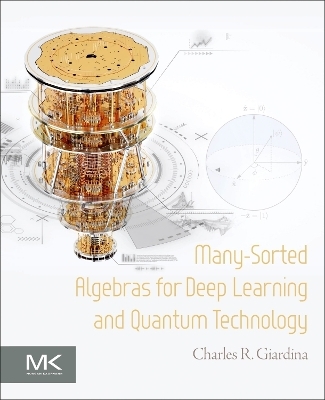
Many-Sorted Algebras for Deep Learning and Quantum Technology
Morgan Kaufmann Publishers In (Verlag)
978-0-443-13697-9 (ISBN)
description of basic concepts in quantum technologies and how they relate to deep learning and quantum theory. Current merging of quantum theory and deep learning techniques provides the need for a source that gives readers insights into the algebraic underpinnings of these disciplines. Although analytical, topological, probabilistic, as well as geometrical concepts are employed in many of these areas, algebra exhibits the principal thread; hence, this thread is exposed using many-sorted algebras. This book includes hundreds of well-designed examples that illustrate the intriguing concepts in quantum systems. Along with these examples are numerous visual displays. In particular, the polyadic graph shows the types or sorts of objects used in quantum or deep learning. It also illustrates all the inter and intra-sort operations needed in describing algebras. In brief, it provides the closure conditions. Throughout the book, all laws or equational identities needed in specifying an algebraic structure are precisely described.
Charles R. Giardina was born in the Bronx, NY, on December 29, 1942. He received the B.S. degree in mathematics from Fairleigh Dickinson University, Rutherford, NJ, and the M.S. degree in mathematics from Carnegie Institute of Technology, Pittsburgh, PA. He also received the M.E.E. degree in 1969, and the Ph.D. degree in mathematics and electrical engineering in 1970 from Stevens Institute of Technology, Hoboken, NJ. Dr. Giardina was Professor of Mathematics, Electrical Engineering, and Computer Science at Fairleigh Dickinson University from 1965 to 1982. From 1982 to 1986, he was a Professor at the Stevens Institute of Technology. From 1986 to 1996, he was a Professor at the College of Staten Island, City University of New York. From 1996, he was with Bell Telephone Laboratories, Whippany, NJ, USA. His research interests include digital signal and image processing, pattern recognition, artificial intelligence, and the constructive theory of functions. Dr. Giardina has authored numerous papers in these areas, and several books including, Mathematical Models for Artificial Intelligence and Autonomous Systems, Prentice Hall; Matrix Structure Image Processing, Prentice Hall; Parallel Digital Signal Processing: A Unified Signal Algebra Approach, Regency; Morphological Methods in Image and Signal Processing, Prentice Hall; Image Processing – Continuous to Discrete: Geometric, Transform, and Statistical Methods, Prentice Hall; and A Unified Signal Algebra Approach to Two-Dimensional Parallel Digital Signal Processing, Chapman and Hall/CRC Press.
Introduction to quantum many-sorted algebra
Basics of deep learning
Basic algebras underlying quantum and neural net
Quantum Hilbert spaces and their creation
Quantum and machine learning applications involving matrices
Quantum annealing and adiabatic quantum computing
Operators on Hilbert space
Spaces and algebras for quantum operators
Von Neumann algebra
Fiber bundles
Lie algebras and Lie groups
Fundamental and universal covering groups
Spectra for operators
Canonical commutation relations
Fock space
Underlying theory for quantum computing
Quantum computing applications
Machine learning and data mining
Reproducing kernel and other Hilbert spaces
| Erscheinungsdatum | 10.02.2024 |
|---|---|
| Verlagsort | San Francisco |
| Sprache | englisch |
| Maße | 191 x 235 mm |
| Gewicht | 860 g |
| Themenwelt | Informatik ► Theorie / Studium ► Künstliche Intelligenz / Robotik |
| Mathematik / Informatik ► Mathematik ► Algebra | |
| Naturwissenschaften ► Biologie | |
| ISBN-10 | 0-443-13697-1 / 0443136971 |
| ISBN-13 | 978-0-443-13697-9 / 9780443136979 |
| Zustand | Neuware |
| Haben Sie eine Frage zum Produkt? |
aus dem Bereich


